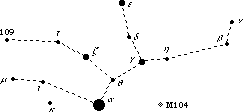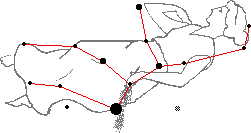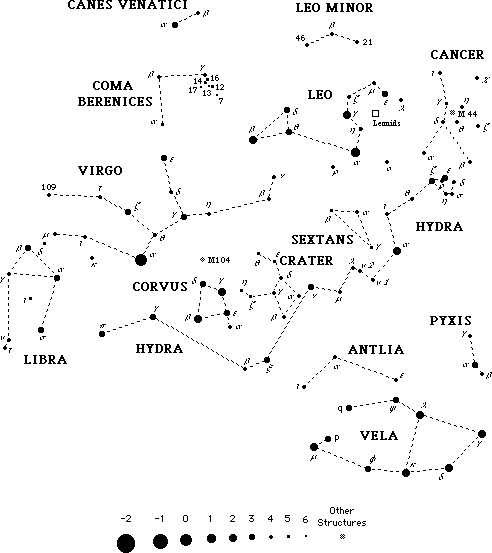|

Per the night
sky, Virgo -- the Virgin -- rises in the East in March, the month of
the Annunciation, as if to remind us
of the words of Isaias and St. Luke:
Isaias 7:14
Therefore the Lord himself shall give you a sign. Behold a virgin shall
conceive, and bear a son and His Name shall be called Emmanuel.
Luke 1:26-35
And in the sixth month, the angel Gabriel was sent from God into a city
of Galilee, called Nazareth, To a virgin espoused to a man whose name
was Joseph, of the house of David; and the virgin's name was Mary. And
the angel being come in, said unto her: Hail, full of grace, the Lord
is with thee: blessed art thou among women. Who having heard, was
troubled at his saying, and thought with herself what manner of
salutation this should be.
And the angel said to her: Fear not, Mary, for thou hast found grace
with God. Behold thou shalt conceive in thy womb, and shalt bring forth
a son; and thou shalt call his name Jesus. He shall be great, and shall
be called the Son of the most High; and the Lord God shall give unto
him the throne of David his father; and he shall reign in the house of
Jacob for ever. And of his kingdom there shall be no end.
And Mary said to the angel: How shall this be done, because I know not
man? And the angel answering, said to her: The Holy Ghost shall come
upon thee, and the power of the most High shall overshadow thee. And
therefore also the Holy which shall be born of thee shall be called the
Son of God.
Virgo's
brightest jewel is the star that makes up the branch the Virgin holds
in her left hand, a large, bluish-white star 262 light years away and
known as Spica, which means "branch of wheat." In Hebrew, this star --
the tenth brightest of the Northern hemisphere -- is
known as "Tsemech" -- "Branch" or "bud" -- the exact same Hebrew word
used to
prophesy of the Messias in the verses below. How perfectly Spica
recalls the words of
Jeremias and Isaias:
Jeremias 23:5-6
Behold the days come, saith the Lord, and I will raise up to David a
just branch: and a king shall reign, and shall be wise: and shall
execute judgment and justice in the earth. In those days shall Juda be
saved, and Israel shall dwell confidently: and this is the name that
they shall call him: The Lord our just One.
Isaias 4:2
In that day the bud of the Lord shall be in magnificence and glory, and
the fruit of the earth shall be high, and a great joy to them that
shall have escaped of Israel.
Isaias foretold
that the Christ would spring from the "root of Jesse," David's father,
and this He did physically through the virginal body of Our Lady, who
was
of the House of David, and, legally, through St. Joseph, also of the
House of David. We recall the fulfillment of this prophecy each Advent with our Jesse Trees and in our O Antiphons, in which Christ is
referred to as "Radix Jesse":
Isaias 11:1-2
And there shall come forth a rod out of the root of Jesse, and a flower
shall rise up out of his root. And the spirit of the Lord shall rest
upon him: the spirit of wisdom, and of understanding, the spirit of
counsel, and of fortitude, the spirit of knowledge, and of godliness.
Decan One: Coma
Berenices
Next, there is
the L-shaped constellation now known since ca. 250 B.C. as "Coma
Berenices" -- a stellar symbol of the hair of Berenice, consort of
Ptolemy III, ruler of Egypt. This constellation was not listed in the
Greek astronomer Ptolemy's catalogue of
forty-eight constellations, but was
depicted in some ancient Zodiacs -- such as at the Temple at Denderah
in Egypt -- as a young woman, sitting on a throne, holding an
infant boy, a most perfect symbol of Our Lady. This constellation's
second brightest star is known as "Diadem" -- "crown of royalty"
-- and it will be directly overhead in the night sky for much of the
month of May, the month dedicated to Our Lady and which begins with her crowning and ends with the celebration of her Queenship.
Decan Two: Centaurus
If you look on the Southern horizon while
Virgo is visible, you will see a constellation of 35 stars named
Centaurus -- a centaur being a creature with two natures. To the
Greeks, this constellation was known as "Cheiron" after the most wise,
gentle, and learned of all Centaurs. Cheiron, immortal because he was a
son of a god, was pierced by an arrow and gave his immortality to
Prometheus, allowing himself to die. Centaurus sits right over the
Crux, or Southern Cross, the constellation of the first decan of the
next Zodiac sign, Libra. A two-natured being
that dies so another might live, who else can this constellation
signify than Jesus, especially given that the Cross is nearby?
Decan Three: Bootes
Finally, on the Eastern horizon, we have the kite-shaped constellation
Bootes (pronounced "Boh-oh-teez") -- a constellation pictured and known
as "The Herdsman" -- or shepherd. Throughout the
New Testament, Christ is referred as the Shepherd, and His followers
as sheep. Christ Himself says outright, as recorded in John 10:14, "I
am the good shepherd; and I know Mine, and Mine know Me."
Even just before His death, at the Last Supper, He warned, in the
Gospel according to St. Matthew 26:31-32, "Then Jesus said to them: All
you shall be scandalized in Me this night. For it is written: I will
strike the shepherd, and the sheep of the flock shall be dispersed. But
after I shall be risen again, I will go before you into Galilee."
What else can Bootes refer to other than Lord Christ?
This
constellation's brightest star -- indeed, the second brightest star in
the
Northern Hemisphere -- is
called "Arcturus," the "Bear-Watcher," and it can be found on Bootes's
Western knee (the lowest point of the "kite" shape)." You can find
Arcturus by
locating the Big Dipper ("Plough") -- an asterism in Ursa Major, a
decan of Cancer -- and
following along the arc of its handle until you come to the brightest
star you can see. This beautiful star is mentioned in the Books of Job
(9:9 and 38:31) and Amos (5:8); hence, it is sometimes referred to as
"Job's Star."

Virgo will have
just become fully visible in the East in March, the month of the
Annunciation when the Branch of Jesse was conceived of the Virgin Mary,
by the Holy Ghost. It can be seen in the Spring and Summer in the
Northern Hemisphere.
 
Virgo relative
to other stars in the Spring sky:

|
|

![]()
